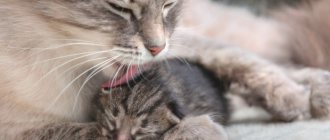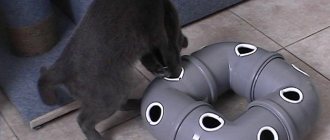Box for giving birth to a cat - how to create a birthing box for your pet?
It is necessary to prepare the place for the cat's birth in advance, preferably 2 weeks before the birth. This will provide comfortable conditions for the animal and protect future offspring. The maternity house can be purchased ready-made or made with your own hands. To equip and decorate such a home, you need a small amount of materials and basic skills in working with tools. The main thing is to take into account the size of the cat and leave room for offspring.
Maternity house: what is it?
A birthing box is a small home for a pregnant cat and her future kittens.
A special box that can be disassembled and assembled is installed indoors so that the cat can comfortably raise offspring. It is made from pet-safe material that is resistant to germs, infections, and does not absorb the smell of pet urine. Such a house is designed individually according to the owner’s requests or is sold ready-made. The birthing area has a door through which the animal can exit as needed, and sides to prevent kittens from getting out.
Possible complications and procedure
Complications can occur at any stage of labor. All pathologies of cat pregnancy can be diagnosed and solved.
Dystocia (obstructed birth) is classified in origin as maternal and fetal, caused by problems with the cat or intrauterine development of the kittens. It may be caused by obstruction of the birth canal or functional inertia of the uterine muscles.
Obstructive dystocia is caused by a disproportion between the size of the kittens and the maternal birth canal.
Functional dystocia manifests itself in rare and weak contractions of the uterus. For dystocia, radiography and cesarean section are indicated.
Inversion of the gravid uterus and uterine rupture can cause serious consequences in the last stage of pregnancy. When the uterus is torsion, the cat is unable to deliver the fetus or fetuses, as a result of which her condition worsens and the kittens die in the womb. Uterine rupture occurs rapidly, causing the fetuses to fall into the abdominal cavity.
The cause of rupture can also be uterine torsion. Excessive bleeding leads to death in the giving birth cat and her offspring. In these cases, urgent surgical intervention is required.
If a cat cannot give birth to a kitten on her own, she needs help. The half-stuck kitten is wrapped in sterile gauze and gently stretched during each contraction.
It must be remembered that there is always a risk of the kitten drowning in amniotic fluid if the process of separating the placenta and clearing the kitten's airway takes too long. A dead fetus in utero can itself lead to functional or obstructive dystocia.
It happens that the fetus dies in the womb even before labor begins. This occurs as a result of infectious diseases suffered by the cat during pregnancy or intrauterine growth retardation.
The cat's suppression of the natural physical process of birth can cause the kitten to be delayed as it passes through the mother's pelvis. The cat feels physical pain and consciously refuses to try to give birth or waits for outside help, without which the kitten will die.
Kitty
A cat that has become a mother begins to wash the newborn kittens from the amniotic sac with care and diligence. In this situation, human intervention is not required. In situations where the mother cat does not show her maternal instinct or the kitten is not breathing, she needs prompt help. You should imitate the actions of a cat:
- Clear the kitten's nasal passage and mouth of mucus. Any liquid that enters the respiratory tract must be sucked out using special equipment. From available means, you can use a catheter attached to a syringe.
- Cut the kitten's umbilical cord at a distance of 4-5 cm from the belly, cauterize it with iodine or peroxide.
- Stimulation of breathing is provided by stroking the kitten's abdominal cavity. If he is not breathing, the airways are first cleared of mucus. You need to breathe air into the kitten's nose and mouth. You should not inhale a large volume of air - the lungs of a newborn kitten are very tiny.
- Absence of heartbeat is a direct indication for chest compressions. The kitten's chest is squeezed rhythmically with the thumb and forefinger. Pressure on the chest alternates every 10-15 seconds with inhalation of air. Resuscitation actions are carried out within five minutes in the absence of a heartbeat, within 20 minutes in case of a weak heartbeat. An effective way is to use doxapram drops. They are dripped onto the kitten's tongue.
- Provide the kitten with physical contact with its mother or ensure that the room temperature is kept warm. Newborn kittens do not know how to properly regulate their heat exchange.
Why is it needed?
It is necessary to prepare a home for the birth of kittens for the following reasons:
The design provides little kittens with protection and comfort.
- offspring safety;
- comfortable life for mother and offspring;
- rest and feeding of animals.
A maternity house is not just a maternity hospital for an animal, but a place where the expectant mother can feed and protect her kittens. It is advisable to prepare such a place for your pet 14-21 days before the onset of labor. The maternity house should be equipped with a heating pad if the birth of small cats occurs during the cold season. It is advisable not only to properly prepare the box for the birth of offspring, but also to prepare brilliant green, round scissors, sterile napkins and flannel cloths, gloves, the necessary medications, a pipette and an enema. These materials may be needed to help your cat give birth. With the right approach, it is better to deliver the baby with a veterinarian, and then move the born kittens and mother into housing.
How to prepare and arrange?
It is advisable to equip the house with a scratching post and a place for feeding. Drapakas are made from rope, rope or sisal. Old carpet will also work. To make the animal comfortable, it is better not to leave the internal walls empty, but to line them with fleece, plush or fur. The glue for construction is chosen to be non-caustic, so as not to poison the pet. The structure is built to be stable, and the platform and benches are installed at different levels. The cloth should be thin and easy to wash, since the house needs to be cleaned regularly. The appearance of the finished maternity hospital is selected to match the overall interior of the room and the tastes of the owner.
House for giving birth to a cat (nest)
The cat’s birthing house (nest) must be prepared 2-3 weeks before the cat’s expected birth. To do this, you can use an exhibition tent (sterilized or never seen at exhibitions), an arena, a special cage or an ordinary spacious box.
The house for giving birth to a cat should be spacious enough, because... it will contain a cat with kittens and some other items (bowls, tray, heating pad, etc.).
Both the owner and the cat should have equal and convenient access to what is inside the house for the cat to give birth, and it is advisable to create obstacles for the kittens. Therefore, a door is usually cut out in a cardboard box at a short distance from the floor, and tents and playpens are opened just enough so that it is convenient for the cat to get in and out, and the kittens cannot crawl out of it.
A soft but thin cloth is placed at the bottom of the cat’s birthing house, which is easy to wash; instead of cloth, you can use disposable diapers. You should not cover a cat’s birthing house with thick, heavy fabrics (for example, a blanket), because kittens can easily get tangled in the folds and suffocate.
You can put a heating pad in the cat's birthing house, especially if the birth occurs during the cold season. It is better to wrap the heating pad in a cloth so that the kittens do not get burned.
In addition, you can put a tray and bowls with food and water in the cat's birthing house. Some cats eat, drink and go potty between contractions, so to prevent the birth of the next kitten from taking place “on the road,” it is better to place everything closer.
What you should always remember
Your task is to maintain “Nordic” calm. Even if you have never seen a cat give birth before, there is no need to panic. Believe me, our pets perfectly sense the emotional mood of their owners. If you are nervous and panicky, your cat will also be under a lot of stress. This will not help the birth in any way.
Let us immediately warn the “cleanies” that the birth of kittens is a dirty process. There will be blood, mucus, birth waters. Remember that the birth of a kitten wrapped in a kind of “bag” is normal. These are the placental membranes.
- A cat that gives birth must definitely tear this sac for each kitten, since otherwise the baby may well suffocate.
- Each kitten will have an umbilical cord. As with the placenta, the mother cat must chew the umbilical cord.
- The mother will eat the placenta and umbilical cord. This is also completely normal and nothing to worry about. Eating placentas is a physiological mechanism. In the wild, it prevents other predators from discovering a cat's lair.
Always remember that your cat may behave uncharacteristically during labor. She will probably meow loudly, scream, and make other sounds that are uncharacteristic for her. If you hear them, there is no need to panic. Try to remain quiet during labor.
The calmer your pet is, the greater the likelihood of a successful birth. From time to time you can talk to your pet. The sounds of its owner's confident voice will calm the cat down.
Difficulties are rare, but we must not forget about them!
More than 99% of cat births are completed successfully and quickly, even without the intervention of a veterinarian or the owner himself directly at home. But still, never forget that childbirth is a complex process, so the possibility of complications can never be ruled out.
We immediately warn owners: trying to help an animal give birth without having the appropriate experience and qualifications is a very bad idea.
If you don’t know a veterinarian who can come to your aid at any time of the day or night, find the number for 24-hour veterinary help in advance. Ideally (especially if the cat is primiparous), it is generally worth agreeing with a specialist so that he can supervise the entire birth process. Most likely, such a service will not be too cheap, but still the health and life of your pet is much more important.
In addition, it doesn’t hurt to take care of the availability of transport in advance so that, if necessary, you can quickly bring the cat to the clinic. If you don’t have your own car, take care of a quick taxi phone number: in severe cases, the time can be calculated in minutes.
Always try to use the services of the most experienced and competent veterinarians, since poor-quality obstetric care may well lead to the development of extremely serious postpartum complications.
Finally, it doesn’t hurt to set aside a certain amount for veterinary care for your pet and her kittens. Please note that if you call at night and supervise the birth, you may need to spend a little more money. Remember that if necessary, you may need formula to feed kittens (cow's milk is absolutely not suitable), so think about where you can buy it in your city.
Tools and medications needed for cat birth:
• Scissors with rounded ends (medical, disinfect)
• Hand sanitizer
• Natural fiber threads
• Zelenka or iodine
• Sterile petroleum jelly or petroleum jelly
• Disposable syringes with needles (preferably insulin or the smallest in volume)
• A pipette or syringe without a needle or a small enema with a small tip
• Number of a veterinarian ready to come to help at any time
Scissors, thread and brilliant green will be needed to cut, tie and cauterize the umbilical cord.
Disposable syringes and oxytocin are needed to stimulate labor when it is weak, so before giving birth it is worth practicing with injections on tangerines.
A pipette or enema can be used to remove mucus from the respiratory tract of a kitten born in a bladder.
A flannel cloth and ammonia will help out when resuscitating a kitten.
Prepare for your cat's birth in advance so as not to be distracted during the process. All the necessary items for the cat's birth can be folded into one bag and placed in an easily accessible place.
Start of labor
One of the most exciting questions for the owner is how to understand that the cat’s labor has begun. This is actually very easy to determine. In most cases, the onset of the first and subsequent births can be judged by the behavior of the pet:
- screams loudly;
- rushing about;
- actively licks itself;
- looking for a quiet, secluded place.
Start of labor
A caring owner should prepare in advance for the upcoming event by preparing a roomy house covered with soft fabric. A box or basket will do. When contractions occur, the owner must be close to the animal in order to provide emergency assistance to his pet in time, if necessary. Their onset can be judged by the pet’s behavior - breathing changes and becomes heavy, the pet may fall to the floor and roll from side to side.
Basic Rules
When choosing a place where the cat will give birth and the kittens will spend the first weeks of their lives, it is important to adhere to the following rules:
- It should be warm and protected from drafts.
- Definitely safe and comfortable. It is very important to equip the maternity area where no one can accidentally step on the babies.
- Must be quiet and in a dark place.
- It is best to choose natural fabrics and materials.
- The design should be such as to enable the owner to do cleaning without disturbing the animals.
In this case, both the mustachioed mother and the kids will be comfortable. The place for childbirth should be prepared in advance, this will help accustom the animal to its new “house”.
Suitable options
In order for the animal to feel good and not worry too much, the birthing area should be properly prepared in a timely manner. Especially if the cat is pregnant for the first time, an inexperienced owner has to deliver the baby .
- A box for giving birth to a cat is the simplest and most convenient option. At the bottom you need to put something warm and soft, for example, an old sweater, and on it - disposable diapers that are easy to remove and change. Before giving birth, it is advisable to lay a fresh one.
- A cage is also a good option for the birth of kittens. When the kids grow up, it is very easy to wash.
- Box. You can place in it not only soft bedding, but also a feeder, a bowl of water, and if the size allows, even a tray. This way the cat can avoid being away from the babies for a long time.
- Baskets. They are equipped with special mattresses, which can later be washed without any problems. However, this is an open option, so the cat will not feel completely safe.
- Tents. For childbirth, you can also use tents - both exhibition and arched. They are easy to close, so the cat will not be able to constantly carry the kittens from place to place. However, an animal can spill water from a bowl or scatter food, and it is quite difficult to tidy up such a “house” while the kittens are in it.
- Breeders often use playpens as a place for childbirth.
How is estrus going?
The period of estrus depends on the specific animal and ranges from 1–3 weeks. If this process takes longer for your cat, you should contact your veterinarian.
The entire period includes four stages:
- Proestrus
- preparatory stage. It lasts one or two days. Usually at this time the cat becomes more affectionate and requires more attention;
- Estrus
- a favorable period for mating. The cat not only purrs or meows, but begins to literally scream, inviting the cat. When touched, she falls on her paws and moves her tail away. If you are annoyed by this behavior of your pet, do not scold him under any circumstances, since instincts are to blame for this; the cat itself does not understand what is happening. Estrus lasts about 1 week;
- Interestrus
- the period between heats, if there was no ovulation. This is a short interval between the end and the next heat. If there was mating and/or ovulation, this period is called diestrus;
- Anestrus
- seasonal period of complete sexual rest. The frequency of estrus is absolutely individual and, as a rule, is inherited. Usually it is several months.











